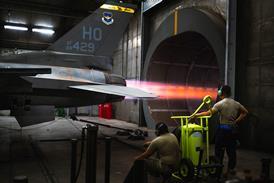President Clinton's attempt to capitalise on China's decision to shift part of the production of its Trunkliner aircraft order from Shanghai to California ignores fundamental changes in China's position that do not bode well for McDonnell Douglas.
Three days before US Congressional elections, Clinton said that the revised Trunkliner agreement boosted US jobs by shifting production of 20 aircraft from China to Long Beach. Ronald Brown, US commerce secretary, who was credited with negotiating the shift during his mid-1994 trip to Beijing, claimed that the agreement demonstrated 'the Clinton administration's policy of commercial engagement with China.'
In fact, the agreement represents China's retreat from a programme that once contemplated assembly of 150 MDC aircraft by Shanghai Aviation Industrial Corp (SAIC). Now SAIC will only build 20 and MDC another 20. Further assembly in China is unlikely.
The first sign of trouble for the Trunkliner programme was the year it took for Beijing's approval. China National Aero-Technology Import & Export Corp (Catic) favoured the programme for its technology transfer benefits, but the CAAC thought it committed China's carriers to too many aircraft that were not their first choice. MDC lost a crucial ally when Catic later disbanded.
In September, SAIC sought a cutback in production and asked to work only on MD-90s. As finally agreed, SAIC will build 20 of the newer type, with Long Beach completing the mix of MD-80s and 90s.
China will pay a $400 million premium for shifting half its purchases to US production, but it can justify that on a $1.6 billion order either in terms of earlier first delivery - 1996 for the US-produced models versus 1998 for Chinese models - or as the price for cutting losses at a profitless Shanghai plant.
Shifting production to California does not breach China's moratorium on aircraft orders. Trunkliner was a pre-existing order, although US politicians heralded the production shift as if it were a new one. Yet, to the extent the moratorium is designed to control foreign exchange, China's decision to buy 20 aircraft overseas creates an obvious drain.
But China's desire to follow its own agenda on building up a commercial aircraft programme is evident in the recent joint venture agreement between Aviation Industries of China and South Korea's Samsung Aerospace to develop and produce a 100-seat regional jet.
SAIC had an earlier offer from MDC to co-produce its 100-seater MD-95 but Shanghai showed no interest. The decision to look elsewhere, at the time, could have been because the MD-95 was little more than an idea when MDC offered it, or because Shanghai was preoccupied with immediate commitments. Now it may be wary of what Bill Becker from Seattle's DCB Aviation Consultants calls 'the sinking ship syndrome,' or more interested in nurturing ties with its Asian neighbours. Whatever the reason, China seems bent on a more independent course.
SAIC had an earlier offer from MDC to co-produce its 100-seater MD-95 but Shanghai showed no interest. The decision to look elsewhere, at the time, could have been because the MD-95 was little more than an idea when MDC offered it, or because Shanghai was preoccupied with immediate commitments. Now it may be wary of what Bill Becker from Seattle's DCB Aviation Consultants calls 'the sinking ship syndrome,' or more interested in nurturing ties with its Asian neighbours. Whatever the reason, China seems bent on a more independent course.
Source: Airline Business























